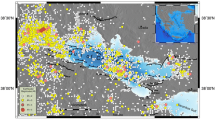Abstract
We present a new method to identify semi-periodic sequences in the occurrence times of large earthquakes, which allows for the presence of multiple semi-periodic sequences and/or events not belonging to any identifiable sequence in the time series. The method, based on the analytic Fourier transform, yields estimates of the departure from periodicity of an observed sequence, and of the probability that the sequence is not due to chance. These estimates are used to make and to evaluate forecasts of future events belonging to each sequence. Numerous tests with synthetic catalogs show that the method is surprisingly capable of correctly identifying sequences, unidentifiable by eye, in complicated time series. Correct identification of a given sequence depends on the number of events it contains, on the sequence’s departure from periodicity, and, in some cases, on the choice of starting and ending times of the analyzed time window; as well as on the total number of events in the time series. Some particular data combinations may result in spectra where significant periods are obscured by large amplitudes artifacts of the transform, but artifacts can be usually recognized because they lack harmonics; thus, in most of these cases, true semi-periodic sequences may not be identified, but no false identifications will be made. A first example of an application of the method to real seismicity data is the analysis of the Parkfield event series. The analysis correctly aftcasts the September 2004 earthquake. Further applications to real data from Japan and Venezuela are shown in a companion paper.









Similar content being viewed by others
References
Bak, P., Tang, C., and Wiesenfeld, K. (1988) Self-organized criticality. Phys. Rev. A 38(1), 364–374.
Bak, P., and Tang, C. (1989) Earthquakes as a self-organized critical phenomenon. J. Geophys. Res. 94(B1), 15635–15637.
Bak, P., and Chen, K. (1991) Self-organized criticality. Sci. Am. 26–33.
Bakun, W., and Lindh, A. (1985) The Parkfield, California earthquake prediction experiment. Science 229, 4714, 619–624.
Bakun, W., Aagard, B., Dost, B., Ellsworth, W., Hardebeck, J., Harris, R., Ji, C., Johnston, M., Langbein, J., Lienkaemper, J., Michael, A., Murray, J., Nadeau, R., Reasenberg, P., Reichle, M., Roeloffs, E., Shakal, A., Simpson, R., and Waldhauser, F. (2005) Implications for prediction and hazard assessment from the 2004 Parkfield earthquake. Nature 437, 969–974. doi 10.1038/nature04067.
Bracewell, R., The Fourier transform and its applications. (McGraw-Hill Book Co., USA, 381 pp., 1965).
Cox, A. (1973) Plate tectonics and geomagnetic reversals. (W. H. Freeman and Co.).
Daley, D., and Vere-Jones, D., An introduction to the theory of point processes, (Springer, USA, 469 pp., 2002).
Fano, R., Transmission of information. (M.I.T Press & J. Wiley & Sons, USA, 389 pp. 1961).
Harte, D., and Vere-Jones, D. (2005) The entropy score and its uses in earthquake forecasting. Pure Appl. Geophys. 162, 1229–1253.
Jackson, D., and Kagan, Y. (2006) The 2004 Parkfield earthquake, the 1985 prediction, and characteristic earthquakes: Lessons for the future. Bull. Seism. Soc. Am. 96, S397–S409.
Kagan, Y. (1997) Statistical aspects of Parkfield earthquake sequence and Parkfield prediction experiment. Tectonophysics 270, 207–219.
Lomnitz, C. (1966) Statistical prediction of earthquakes. Reviews of Geophysics 4, 377–393.
Lomnitz, C., Fundamentals of earthquake prediction. (JohnWiley & Sons Inc., USA, 326 pp. 1994).
Morgan, W. J. (1968). Rises, trenches, great faults, and crustal blocks. J. Geophys. Res. 73(6), 1959–1982.
Quinteros, C., Nava, F., Glowacka, E., and Frez, J. (2013) Semi-periodicity and extraneous events in earthquake forecasting. II: Application, forecasts for Japan and Venezuela. Pageoph accepted.
Richardson, R. M., Solomon, S. C., and Sleep, N. H. (1979) Tectonic stress in the plates. Reviews of Geophysics, 17, 981–1019.
Richter, C., Elementary Seismology, (W. H. Freeman and Co., USA, 768 pp., 1958).
Rikitake, T., Earthquake prediction. (Elsevier, 357 pp., 1976).
Savage, J. (1993) The Parkfield prediction fallacy. Bull. Seismol. Soc. Am. 83, 862–881.
Shimazaki, K., and Nakata, T. (1980) Time predictable recurrence for large earthquakes. Geophys. Res. Letts. 7, 279–282.
Turcotte, D., Fractals and Chaos in Geology and Geophysics. (Cambridge University Press, Second Edition, New York. 221 pp, 1992).
Vere-Jones, D. (1998) Probabilities and information gain for earthquake forecasting. Comput. Seismol. 30, 248–263.
Acknowledgments
This research was partially funded by a CONACYT scholarship 242919 (C. Quinteros) and was partially carried out within project CGL2011-29474-C01-01. Our sincere thanks to Cinna Lomnitz and to an unknown reviewer for helplful criticism and comments; we also would like to express our thanks to editor Andrzej Kijko.
Author information
Authors and Affiliations
Corresponding author
Rights and permissions
About this article
Cite this article
Nava Pichardo, F.A., Quinteros Cartaya, C.B., Glowacka, E. et al. Semi-Periodic Sequences and Extraneous Events in Earthquake Forecasting: I. Theory and Method, Parkfield Application. Pure Appl. Geophys. 171, 1355–1366 (2014). https://doi.org/10.1007/s00024-013-0679-5
Received:
Revised:
Accepted:
Published:
Issue Date:
DOI: https://doi.org/10.1007/s00024-013-0679-5




